Volcanic gas reservoir in Xushen gas field has complex microscopic pore throat structure and dense physical property, which is quite different from that of conventional high-permeability sandstone gas reservoir. It is of great significance to know its seepage mechanism for scientific and efficient development technology countermeasures. Through the parallel and series experiments of volcanic fracture cores and matrix cores, the gas flow changes of fractures and matrix cores with different permeability levels under different pressure gradients were measured, and the percolation mechanism of volcanic gas reservoirs with different pressure gradients was revealed when fractures and matrix cores were in parallel or series. The experimental results show that the fracture is the dominant channel relative to the matrix, and the supply and exhaust capacity of the fracture is much larger than that of the matrix, and the permeability of the matrix determines the supply and exhaust capacity of the series system composed of fracture and matrix.
Keywords: Xushen gas field, Volcanic rock, Percolation mechanisms, Cracks, The substrate
Carbonate gas reservoirs usually have strong heterogeneity. Pores, caves and fractures are developed, buried deeply, reservoir fluid physical properties and gas-water distribution are complex, and water flooding is easy to occur in the process of development.1-8 The volcanic gas reservoirs in Xushen Gas field are well developed with large pores and fractures, middle pores and small pores. 9-12 Therefore, the production process is characterized by "relay" gas discharge and supply in stages. The initial flow process is that the fluid flows to the wellbore from large holes and cracks. In the middle flow process, the mass exchange between the middle pore and the large pore and the large fracture occurs, and the flow range expands. The later flow process is fluid mass exchange between small pore fractures and large-scale pore fractures, and the seepage range is further expanded. Production performance of gas wells in Xushen Gas Field also verifies this seepage feature. Many scholars have done a lot of research on the seepage mechanism and characteristics of sandstone and carbonate gas reservoirs.13-22 Germann23 studied the pore structure of tight carbonate reservoir by means of capillary pressure test, nuclear magnetic resonance method and imbibition experiment. The study shows that there are a large number of karst pores in carbonate matrix. Taking Sulige gas field as the research object, Zhu24 studied the gas percolation characteristics of low permeability gas reservoir. Through natural core experiments, the permeability and pressure conditions of slippage effect of natural gas percolation in reservoir were obtained. Benzagouta et al.25 carried out percolation characteristics experiments under the condition of 100C high temperature. The experimental core is a natural carbonate core, and the carbonate rock has obvious stress sensitive effect. Under different pressure and temperature environment, the core permeability will be quite different. Wang26 established two sets of carbonate rock models and simulated the single-phase flow of gas in fractured and fractured-vuggy carbonate reservoirs through physical simulation experiments of seepage characteristics. Based on the steady percolation theory, Men27 deduced and established the coupling dynamic prediction model of carbonate fracture-cave gas reservoir and horizontal wellbore. Gao and Liu28 carried out seepage law experiments and stress sensitivity experiments, and obtained the seepage and stress sensitivity laws of three types of carbonate rocks.
However, due to the lack of development of volcanic gas reservoirs at home and abroad, there are few experiments to study the seepage mechanism of volcanic gas reservoirs by matrix and fracture. This kind of experiment has important exploration significance to understand the percolation mechanism of volcanic gas reservoir and is beneficial to guide the development of scientific and efficient technical countermeasures for volcanic gas reservoir.
In view of the volcanic rock gas reservoir multiple medium "relay" exhaust gas supply mechanism, set up a using cores and the matrix cracks in parallel, series combination experiment process and devices, testing fracture and matrix core under different pressure gradient and permeability level, under the condition of different fracture and matrix combination the change of gas flow, to achieve the purpose of the research on volcanic rock gas reservoir percolation mechanism system. It provides a theoretical basis for the efficient development of volcanic gas reservoirs.
The experimental sample
In this experiment, a total of 12 volcanic rock cores were taken from Xushen Gas field, including 5 fractured cores and 7 volcanic matrix cores. All cores are in the water porosity range of 3.361~17.14%; Gas permeability range is 0.004~0.87×10-3μm2.
The experimental steps
The experimental temperature is constant temperature (20oC, the core confining pressure is 10MPa, the experimental gas is N2. Gas at the inlet end of the core replaces the pressure 0-4MPa. The core outlet is at atmospheric pressure.
The experimental steps are as follows: Connect the instrument and equipment according to the flow chart, adjust each instrument and equipment to enter the experimental state; Put the experimental core into the core gripper, and use the confining pressure pump to provide a stable confining pressure of 10MPa for the core in the core gripper; Open the gas source and give a certain displacement pressure, check the experimental process, to ensure that there is no leakage after the experiment; Adjust the inlet pressure to the set value, wait for a period of time, when the outlet end flow stability, record the inlet end pressure and outlet end flow; Repeat the previous steps as required until the required test site is completed.
Comparison of fracture and matrix power supply and exhaust capacity
The gas flow rates of fracture and matrix under different pressure gradients were obtained by parallel experiments of fracture and matrix cores. In the experiment, the gas flow rate of cracks and matrix represents their supply and exhaust velocity and reflects their supply and exhaust capacity. (Kf=1.705×10-3m2, Km=0.079×10-3m2).
The experimental results show that for the matrix, the gas velocity increases with the displacement pressure Figure 1, but the increase is small. For fractures, the gas velocity increases with the increase of displacement pressure, and the increase rate is large. Under the same displacement pressure, the gas flow rate in the fracture is much higher than that in the matrix. According to the experimental mechanism, the low production of volcanic gas reservoir in Xushen Gas field can be improved by increasing production pressure difference or fracturing to improve reservoir permeability.
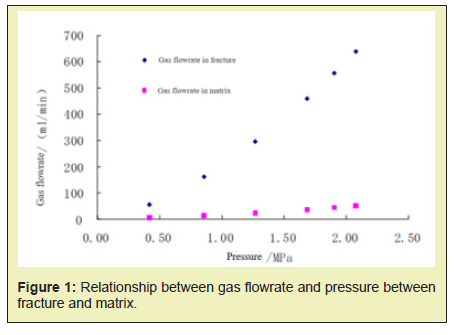
Dominant channel study
When the matrix and fracture are connected in parallel, the relationship between the percentage of matrix flow in the total flow in parallel and the permeability of fracture (matrix) is used to reflect the dominant channel in the experiment of supply and exhaust mechanism.
The experimental results show that under the same pressure gradient, the matrix permeability remains unchanged, and the gas flow rate of the matrix decreases linearly and exponentially when the fracture permeability increases Figure 2. When the fracture permeability remains unchanged and the matrix permeability increases, the matrix gas flow increases logarithmically but nonlinearly Figure 3. The larger the permeability difference between fracture and matrix, the smaller the proportion of gas flow through matrix to the total flow in parallel, and the larger the proportion of gas flow through fracture. It can be seen that when the matrix and fracture are in parallel, the fracture is the dominant channel relative to the matrix. The larger the difference of permeability between fracture and matrix, the stronger the supply and exhaust capacity of fracture relative to matrix
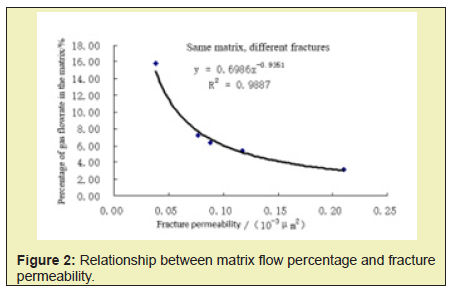
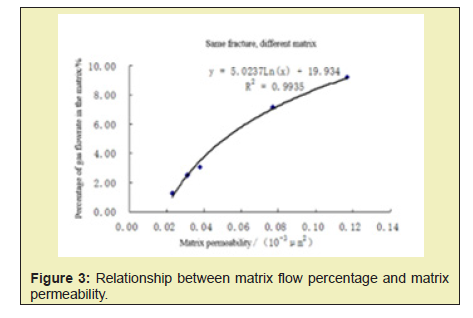
Study on influence factors of supply and exhaust capacity
Influence of permeability and displacement pressure: When the fracture and matrix are connected in parallel, the fracture (matrix) permeability is unchanged and the matrix (fracture) permeability is changed. The influence of matrix (fracture) permeability and displacement pressure on the supply and exhaust capacity of matrix (fracture) under different displacement pressures is studied.
The experimental results show that the matrix and fracture are in parallel, and the fracture permeability is unchanged. When the matrix permeability is changed, the matrix supply and exhaust velocity increases logarithmically with the increase of matrix permeability. The higher the displacement pressure of the matrix, the higher the supply and exhaust velocity Figure 4. When the matrix permeability is unchanged and only fracture permeability is changed, the fracture supply and exhaust velocity increases linearly with the increase of fracture permeability. The higher the displacement pressure, the higher the supply and exhaust velocity Figure 5. It can be seen that the supply and exhaust capacity of fractures and matrix is affected by their own permeability and displacement pressure.
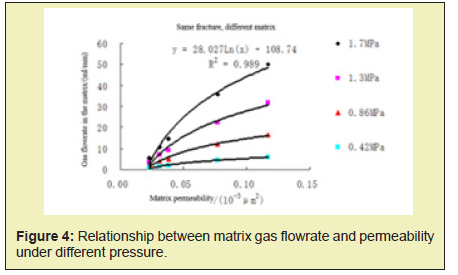
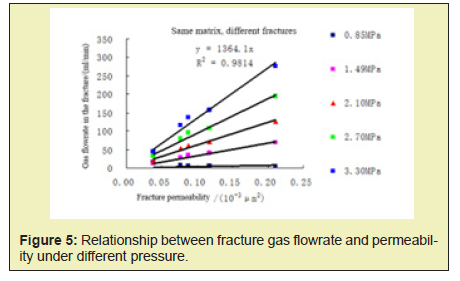
Matrix and fracture length: The experimental comparison and analysis of long fracture core in parallel with single matrix core, single fracture core in parallel with single matrix core, and single fracture core in parallel with long matrix core are carried out. The experimental results show that the flow rate of long fracture and single matrix parallel fracture is obviously smaller than that of single fracture and single matrix parallel fracture. The flow rate of the matrix in parallel with single fracture or long matrix is significantly smaller than that of the matrix in parallel with single fracture or single matrix, that is, the supply and exhaust capacity of the fracture (matrix) decreases with the increase of the length of the fracture (matrix), especially the supply and exhaust capacity of the matrix decreases sharply with the increase of its own length Table 1. It can be seen that the supply and exhaust capacity of cracks and matrix is also affected by their length.

The effect of pressure gradient: Under different pressure gradients, the proportion of gas flow through the matrix to the total flow is used to reflect the influence of pressure gradient on the supply and exhaust capacity of the system. The experimental results show that: when the matrix is in parallel with the fracture, and the matrix is unchanged but the fracture is changed, the proportion of the matrix gas flow in the total flow in parallel tends to decrease with the increase of the pressure gradient, and the variation range is small Figure 6. When the permeability of matrix is unchanged, the ratio of matrix gas flow to the total flow in parallel changes slightly with the increase of pressure gradient Figure 7. However, the ratio of matrix gas flow to the total flow varies with different matrix permeability: When matrix permeability is small, the ratio of matrix flow to total flow decreases with the increase of pressure gradient. When matrix permeability is large, the ratio of matrix flow to total flow decreases first, then increases and even gradually increases with the increase of pressure gradient. It can be seen that when matrix and fracture are in parallel, the ratio between matrix and fracture supply and exhaust capacity is basically not affected by the pressure gradient, but when matrix permeability increases to a certain extent, the matrix supply and exhaust capacity will be significantly enhanced with the increase of pressure gradient.
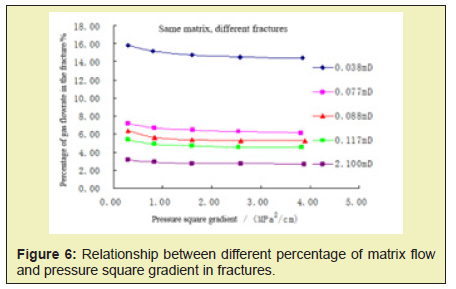
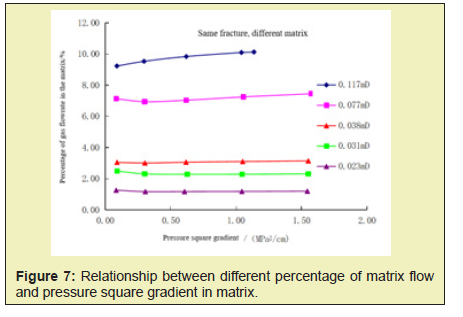
Effect of gas flow sequence on gas supply and exhaust velocity
Through the different gas flow sequence between fractured core and matrix core, the influence of fracture and matrix composition series system on gas supply and exhaust capacity was studied Figure 8. The experimental results show that when the pressure gradient is constant, the air supply and exhaust velocity of crack and matrix has little influence, and the air supply and exhaust velocity of crack is slightly higher than that of matrix. With the increase of pressure gradient, the supply and exhaust velocities increase linearly in modes.
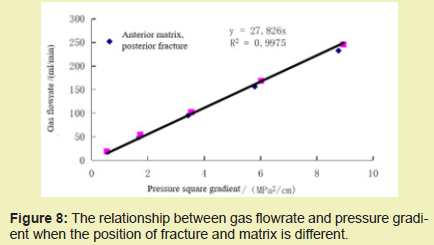
Study on the supply and exhaust law of crack as gas source and matrix as exhaust channel
The same fracture matrix is different: When the gas supply and exhaust system is composed of cracks and matrix in series, the cracks are used as the gas supply source, and matrix with different permeability is used as the exhaust channel. The influence of matrix permeability on series system under different displacement pressures is analyzed, and the increase of gas flow rate in series system is compared with that of matrix permeability. The experimental results show that under certain displacement pressure, the supply and exhaust velocity of the series system increases logarithmically with the increase of matrix permeability. Under the same matrix permeability condition, the higher displacement pressure, the higher the supply and exhaust velocity of the series system Figure 9. With the increase of matrix permeability multiple as exhaust channel, the supply and exhaust velocity of the whole series system increases logarithmically. The increase of supply and exhaust velocity multiple in series system is greater than that of matrix permeability multiple Figure 10.
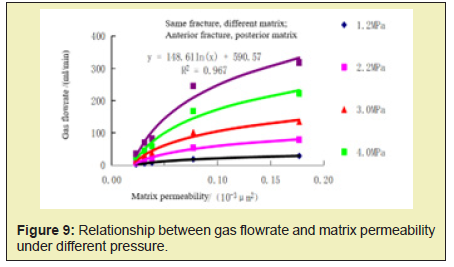
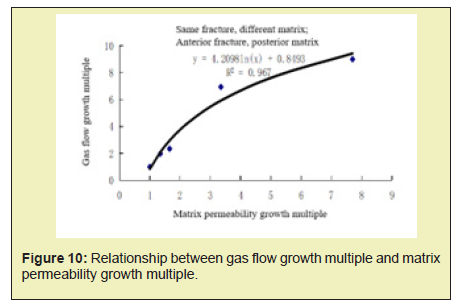
Same matrix, different cracks: When the supply and exhaust system is composed of cracks and matrix in series, matrix is used as exhaust channel, and cracks with different permeability are used as gas supply source. The influence of fracture permeability on the series system under different displacement pressures was analyzed, and the increase of gas flow rate in the series system was compared with that of fracture permeability, as shown in Figures 11 and 12.
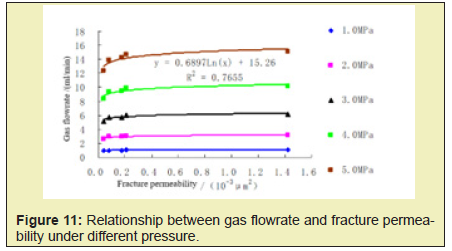
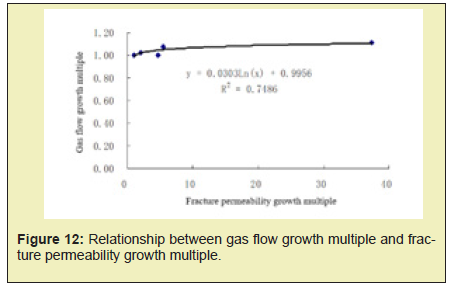
The experimental results show that under certain displacement pressure, the supply and exhaust velocity of series system increases logarithmically with the increase of fracture permeability, but the increase rate is small. Under the same fracture permeability condition, the higher the displacement pressure, the higher the supply and exhaust velocity. With the increase of fracture permeability multiple as gas source, the supply and exhaust velocity of the whole series system increases logarithmically. However, the increase of supply and exhaust velocity in series system is far less than that of fracture permeability, which indicates that matrix permeability determines the supply and exhaust velocity in the whole supply and exhaust system.
The matrix is the gas source, and the crack is the supply and exhaust law of the exhaust channel
Cracks are different from the same matrix: When the crack and the matrix are connected in series to form the supply and exhaust system, the crack is used as the exhaust channel, and the matrix with different permeability is used as the gas supply source. The effect of matrix permeability on the tandem system under different displacement pressure conditions was analyzed, and the increase in gas flow rate in the tandem system was compared with the increase in matrix permeability. The experimental results show that under certain displacement pressure conditions, when the matrix is the gas source and the crack is used as the exhaust channel, the speed of supply and exhaust of the tandem system increases logarithmically with the increase of the matrix permeability, and the greater the displacement pressure under the same matrix permeability conditions, the greater the speed of supply and exhaust of the tandem system Figure 13. With the increase of the matrix permeability multiple as the gas source, the speed of supply and exhaust of the entire tandem system increases logarithmically, and the increase in the supply and exhaust velocity of the tandem system is greater than the increase in the permeability of the matrix Figure 14.
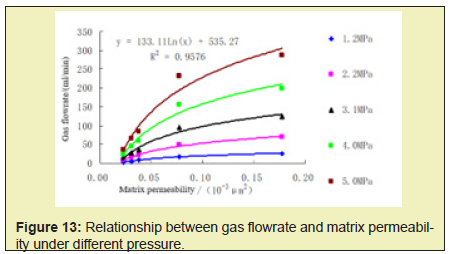
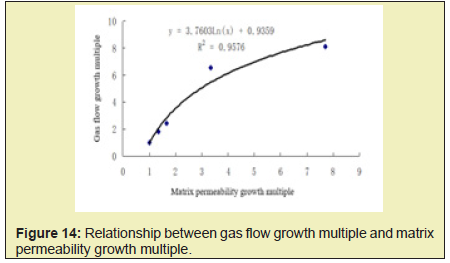
The matrix is different from the same crack: When the crack and the matrix are connected in series to form the supply and exhaust system, the matrix is used as the gas supply source, and the cracks with different permeability are used as the exhaust channel. The influence of crack permeability on the tandem system under different displacement pressure conditions was analyzed, and the increase in gas flow in the tandem system was compared with the increase in crack permeability. The experimental results show that under certain displacement pressure conditions, the supply and exhaust velocity of the series system increases logarithmically with the increase of fracture permeability as the exhaust channel. With the same fracture permeability, the higher the displacement pressure, the higher the supply and exhaust velocity Figure 15. With the increase of the permeability multiple of the fracture as the exhaust channel, the overall supply and exhaust velocity increases logarithmically. However, the increase of supply and exhaust velocity is less than that of fracture permeability Figure 16, which further indicates that matrix permeability determines the supply and exhaust velocity in the whole supply and exhaust system.
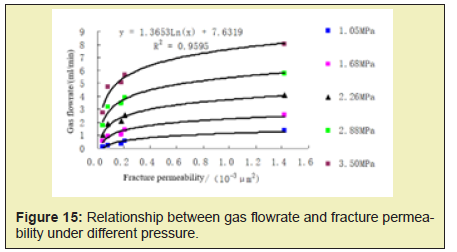
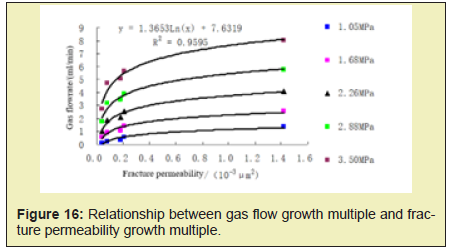
Effect of matrix (crack) length on the supply and exhaust capacity of tandem systems
Two matrices (cracks) with the same permeability are used in tandem to form a long matrix (crack), and then connected with the cracks (matrix) to form a tandem system. The gas flow of different combination tandem systems was observed as a function of displacement pressure, so as to study the influence of matrix (crack) length on the supply and exhaust capacity of tandem system. Two series methods of crack as air source and matrix as gas source are designed, and the supply and exhaust capacity of the tandem system is compared to increase the length of the crack, increase the length of the matrix and neither increase. The experimental results show that under the same displacement pressure, the gas flow of the two fractures and a matrix composed of a series system is slightly less than that of a crack and a matrix composed of a series system, and the gas flow of the two matrices and a fracture composing a series system is significantly smaller than that of a crack and a matrix composing a series system, and the gap is more and more obvious with the increase of the displacement pressure Figures 17 and 18. It can be seen from this that whether the fracture is the air source or the matrix is the gas source of the tandem system, with the increase of the length of the crack and the matrix, the supply and exhaust capacity of the tandem system will weaken to varying degrees; the increase of the length of the crack has less impact on the supply and exhaust capacity of the tandem system, and the increase of the matrix length has a significant impact on the supply and exhaust capacity of the tandem system.
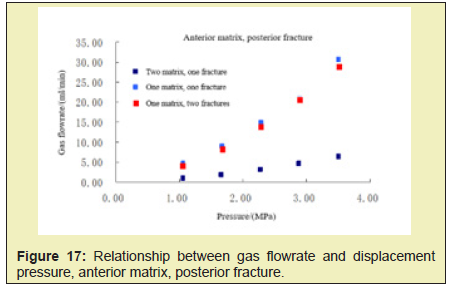
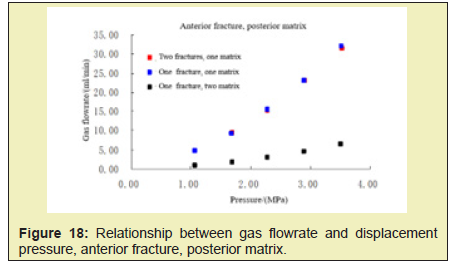
Study of the supply and exhaust time of the tandem system
With the same set of cracks and matrices, the matrix as the gas supply source, the crack as the exhaust channel and the crack as the gas supply source, the matrix as the exhaust channel, the displacement time required to achieve the same flow under the same displacement pressure conditions, and the matrix (crack) unchanged, the fracture (matrix) is changed permeability to study the effect of crack (matrix) permeability on the supply and exhaust time.
The experimental results show that to achieve the same supply and exhaust velocity, the replacement time required for the fracture for the gas source is smaller than that of the gas supply and exhaust system with the substrate as the gas source, and the larger the supply and exhaust speed required, the more obvious the gap is, and there is a good exponential relationship between the displacement time and the gas flow rate Figure 19 When the matrix and the fracture are connected in series, and the permeability of the matrix is changed unchanged, the tandem system reaches the same supply and exhaust velocity, and the required displacement time decreases logarithmically with the increase of the matrix permeability Figure 20. When the matrix and the crack are connected in series, the matrix does not change the permeability of the crack, the same supply and exhaust velocity is achieved, and when the fracture permeability is less than 0.2×10-3m2μ, the required displacement time decreases sharply with the increase of the permeability; when the fracture permeability is greater than 0.2 When ten ×10-3m2μ, the required displacement time is basically unchanged with the increase of the permeability, indicating that when the fracture permeability reaches a certain level, the supply and exhaust velocity of the entire tandem system depends on the permeability of the matrix Figure 21.
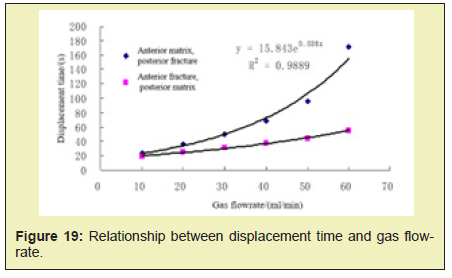
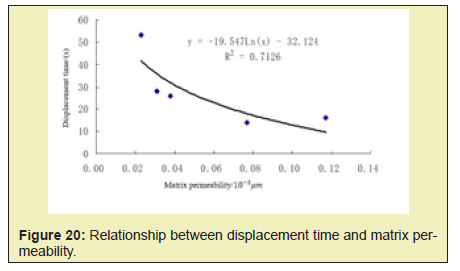
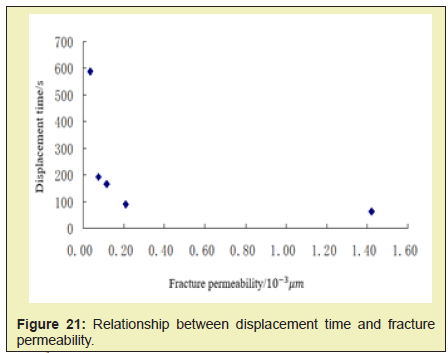
- 1. It can be seen from the parallel experiments of volcanic rock matrix and fracture core in Xushen gas field that the crack is the dominant channel relative to the matrix, and the gas supply and exhaust capacity of the fracture is much greater than the supply and exhaust capacity of the matrix; increasing the pressure gradient or permeability can improve the supply and exhaust capacity of the fracture and the matrix; the smaller the difference between the matrix and the fracture, the stronger the supply and exhaust capacity of the matrix relative to the entire system; in the development and production process of the volcanic rock gas reservoir, try to achieve perforation in the stratum section of the fracture development and increase the production pressure difference At the same time, it is also necessary to take into account the difference in the permeability level between the crack and the matrix.
- 2. It can be seen from the tandem experiments of volcanic rock matrix and fracture core in Xushen gas field that the sequence of gas flow through the matrix and the fracture has little impact on the supply and exhaust capacity of the entire system; the permeability of the matrix determines the supply and exhaust capacity of the series system composed of the crack and the matrix, and the increased permeability of the matrix has a very obvious effect on the increase of the supply and exhaust capacity of the entire system.
- 3. For volcanic rock reservoirs where the bedrock reserves of Xushen gas field occupy the main position, drilling wells in the position of good matrix properties on the plane, perforation of the fracture developing layer section in the longitudinal direction or fracturing modification, and transformation of the seepage capacity of the matrix in the development process are all effective means for efficient development of volcanic rock gas reservoirs.
None.
None.
Authors declare that there is no conflict of interest.
- 1. Correia MG, Maschio C, Schiozer DJ. Integration of multiscale carbonate reservoir heterogeneities in reservoir simulation. Journal of Petroleum Science and Engineering. 2015,131:34-50.
- 2. He JH, Li M, Zhou KM, et al. Effects of vugs on resistivity of vuggy carbonate reservoirs Effects of vugs on resistivity of vuggy carbonate reservoirs. Petroleum Exploration and Development. 2020;47(3):527-535.
- 3. Li RF, Bao ZD, Pang XQ, et al. Sequence Stratigraphic Features of Weathered Carbonate Residuum Reservoirs. Energy Exploration & Exploitation. 1999;17(3-4):269-276.
- 4. Rao Y, Wang Y H. Stabilised inverse-Q filtering for seismic characterisation of carbonate reservoirs. Journal Of Geophysics and Engineering. 2019;16(1):190-197.
- 5. Shen AJ, Zhao WZ, Hu AP, et al. Major factors controlling the development of marine carbonate reservoirs. Petroleum Exploration and Development. 2015;42(5):597-608.
- 6. Shi S S, Belhaj H, Bera A. Capillary pressure and relative permeability correlations for transition zones of carbonate reservoirs. Journal of Petroleum Exploration and Production Technology. 2018;8(3):767-784.
- 7. Singh KH, Kumar A, Pandit S, et al. Partitioning of Porosity for Carbonate Reservoirs Using Differential Effective Medium Models. Workshop on Challenges in Petrophysical Evaluation and Rock Physics Modeling of Carbonate Reservoirs. 2020;129-143.
- 8. Zhao B, Zhu GY, Shang YJ, et al. Predicting collapse depth of paleocaves in carbonate reservoirs. Carbonates and Evaporites. 2021;36(2).
- 9. Yan L, Zhou X, Gao Tao, et al. Analysis on controlling factors of volcanic reservoir development in Xingcheng development zone of Xushen gas field. Petroleum Geology and Development in Daqing, 2007;26(2):9~13.
- 10. Shu P, Ji Xue Y, Ding R, et al. Study on fracture characteristics of volcanic reservoir in Xushen gas field. Petroleum Geology and Development in Daqing. 2008;27(1):13-17.
- 11. Wang J, Geng S. Logging identification method of volcanic lithology and its control on reservoir physical properties. Petroleum Geology and Development in Daqing. 2008;27(2):136-139.
- 12. Ding R. Prediction and classification of volcanic reservoirs in Xushen 21 block of Xushen gas field. Natural gas industry. 2009;29(8):22-25.
- 13. Liu Z, Yang Z, Liu X, et al. Experimental study on nonlinear percolation in low permeability reservoir. Science and technology guide. 2009;27(17):57-60.
- 14. Li X, Xiao C, Yuan S, et al. Study on percolation mechanism of ultra-low permeability conglomerate reservoir-taking Lower Wuerhe formation reservoir in area 8 as an example. Xinjiang oil and gas. 2015;11(1):37-41.
- 15. Shu Q, Guo Y, Sun Z, et al. Study and application of percolation mechanism in ultra-low permeability reservoir. Oil and gas geology and recovery. 2016;23(5):58-64.
- 16. Xue H, Tang Y, Guo H, et al. Effects of different percolation mechanisms on horizontal well productivity in tight sandstone reservoirs. Chinese scientific and technological papers. 2017;12(3):263-268.
- 17. Du D, Zhao Y, Zhang J, et al. Progress and Trends in Shale Gas Seepage Mechanism Research. Journal of Southwest University of Petroleum. 2017;39(4):136-144.
- 18. Qu Y, Liu Q. Study on pore structure and percolation mechanism of basic volcanic reservoir in Anda sag, northern Songliao Basin. Natural gas exploration and development. 2018;41(1):69-73.
- 19. Sun Z, Ma B, Li F. Analysis of nonlinear percolation mechanism and characteristics of fluid in low permeability reservoir. Journal of Southwest University of Petroleum. 2019;41(2):109-117.
- 20. Ma Y, Chai X, Lian Y, etc. Percolation mechanism and development simulation of multi-layer co-production gas reservoir. Petroleum geology of Xinjiang. 2019;40(5):570-574.
- 21. Wang Z, Li C, Zhang D, et al. Percolation mechanism of shale reservoir in Jimusar sag. Petroleum geology of Xinjiang, 2019;40(6):695-700.
- 22. Zhang L, Liu R, Leng Y. Percolation mechanism and development characteristics of high-pressure-ultra-high pressure carbonate gas reservoir. Natural gas industry. 2020;40(3):92-98.
- 23. Egermann P, Laroche C, Manceau E, et al. Experimental and Numerical Study of Water/Gas Imbibition Phenomena in Vuggy Carbonates. SPE Reservoir Evaluation & Engineering. 2007;10(01):86-96.
- 24. Zhu G, Liu X, Li S, et al. Study on the influence of gas percolation slippage effect in low permeability gas reservoir. Natural gas industry. 2007;05:44-47.
- 25. Amro M, Benzagouta M. Effect of Pressure and Temperature on Petrophysical Characteristics in the Case of Carbonate Reservoirs. Oil Gas European Magazine. 2009;35(2):74-78.
- 26. Zhu H, Fu D, Zhuo X, et al. Experimental study on special percolation mechanism of low permeability gas reservoir. Natural gas exploration and development. 2009;32(03):39-41.
- 27. Men C, Zhang Q, He S. Horizontal well performance prediction model of carbonate fracture-cave gas reservoir. Science, technology and engineering. 2013;13(17):4783-4786.
- 28. Gao S, Liu H, Ren D, et al. Productivity equation of fracture-cave carbonate reservoir and its influencing factors. Natural gas industry. 2015;35(09):48-54.

